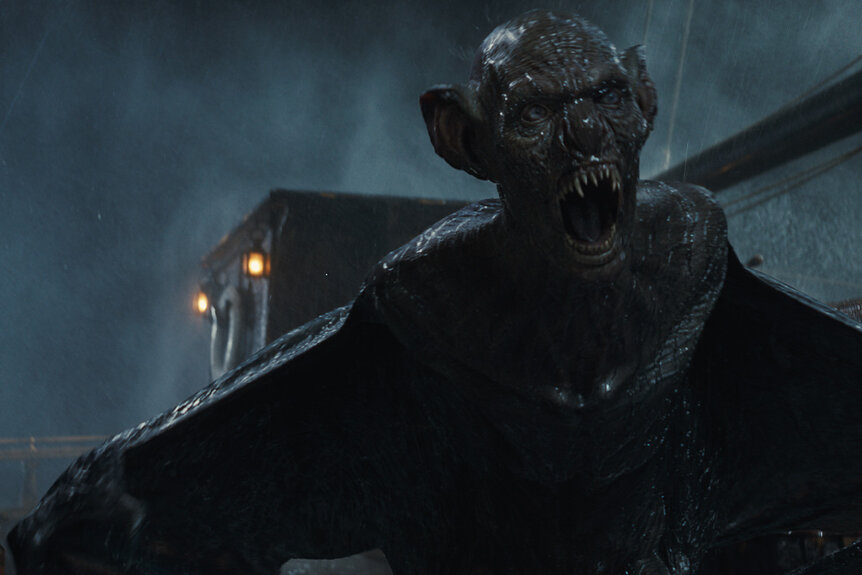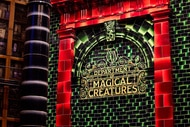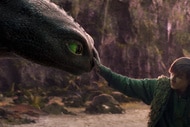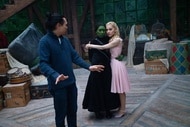Create a free profile to get unlimited access to exclusive videos, sweepstakes, and more!
Inside The 21-Year Journey to Bring The Last Voyage of the Demeter to the Big Screen
Here's why it took two decades to bring one small chapter of Bram Stoker's Dracula to life.
In the 126 years since Bram Stoker publisher Dracula, there have been countless adaptations of the seminal vampire story in every medium, from ballets to musicals. But film is where the Dracula character has arguably had the most visual impact with stellar portrayals from Max Schreck to Bela Lugosi. The most recent addition to that impressive list is Javier Botet, who embodies the skeletal, winged interpretation featured in The Last Voyage of the Demeter.
The film is an interpretation of Chapter 7 of Dracula, which is written like a newspaper cutting from The Dailygraph that details how Dracula traveled via ship from Romania to London, England. In all of the many cinematic versions of Dracula, there's never been a version that has just told the tale of the doomed Demeter and its crew, such as The Last Voyage of the Demeter. At a recent Burbank, California screening of the film attended by SYFY WIRE, producers Brad Fischer and Mike Medavoy and director André Øvredal (Troll Hunter) shared stories with author Leslie S. Klinger about this unique adaptation, which took 21 years to get financed and made.
Why it took two decades to make The Last Voyage of the Demeter
Fischer told the audience that he and Medavoy first optioned a version of the story in 2002 with their partner Arnold Messer. "Bragi F. Schut came up with this idea," he said. "And it continued to fuel our efforts throughout all these years."
RELATED: The Last Voyage of the Demeter is Basically Alien, Just Set in the 1800s on a Ship
Medavoy credited Fischer for his enduring passion for this take on the story as to why it finally got made. "This was unique and I'm always looking for something that's fresh and unique," he said. "The story has been told before, but never this one chapter."
In the two decades of development, Fischer says they had an incredible line-up of director's attached to the script including Robert Schwentke, Markus Nestele, David Slade, Neil Marshall, Patrick Tatopoulos, Stefan Ruzowitzky, and Guillermo del Toro. "Del Toro actually was going to direct it right before Andre came on," Fischer confirmed.
Medavoy added, "And it was Guillermo's idea actually, to do it with Andre. It was his inspiration and he was completely right."
Øvredal said he was honored to be given the opportunity to interpret the Dracula story in such a specific way. And that his previous films had uniquely prepared him for tackling such beloved lore without getting in his own head about it. "I felt like I was mentally prepared because I did it with Scary Stories to Tell in the Dark. They were beloved books so that was daunting in a way," he said. "Also, it wasn't really my culture. I didn't grow up with those books. But I also did it with my first film Troll Hunter, which was all about the Norwegian culture. So, it has kind of become my thing. But, it was definitely daunting because they had been working with so many great directors that I admire for all these years."
Asked about the challenges of adapting just one chapter of a book, Øvredal said usually the problem is having to condense the material to fit within two hours. "In this particular case, we're using only one chapter, so you actually have to expand on it," he said. "It became an exercise for the screenwriter, mostly, to fill out the blanks between the Captain's Log entries. The chapter is mostly written in very simple log entries that get more and more delirious towards the end as he loses his mind and everything falls apart."
Yet even with the necessary additions, Fischer said the final script remains very similar, especially in tone, to the one that was developed 21 years ago. "There were some versions that had a little bit more prologue, pre-ship stuff, and others that played around with the dynamics," he detailed. "But more or less, it was always effectively this movie." He confirmed that the biggest change was the addition of the character of Anna (Aisling Franciosi), who was not a character from the spec script.
Øvredal revealed that the Anna character was actually an idea that his girlfriend came up with during pre-production. "She told me this idea, and I told it to the writer," he said with pride. "And in a way, he gets a credit for it, but it was actually my girlfriend's idea." He added that there was actually more to the story of the empty crates in the hold with Dracula and Anna that will be fleshed out in the home video release later this year. "I wondered: Why would Dracula kill the crew? He can actually take one subject and keep [feeding] on that subject for the entirety of the voyage, which was his plan with Anna," he said. "So, you'll see in this home video release, we have a few deleted scenes that they do actually find more girls."
RELATED: Why The Last Voyage of the Demeter Will Make Dracula Scary Again
Another change made for the movie is Clemen's (Corey Hawkins) medical degree. "That was a very inspired suggestion by the writer I was working with, Zak Olkewicz," Øvredal said. "We actually based him on a real person from around that time — the turn of the century — who was a Black man who had actually succeeded getting into an English university, which was quite unusual at the time."
Fischer continued, "There's a line that Clemens explores between science and reason on the one hand, and the supernatural, which you can't explain. Yet you still have this desperate need to get to the bottom of it because everything should be explainable in some way. He has a philosophical kind of underpinning to him which separates him from the men on this ship. That was an additional dimension that got added very late in the game, probably in the months while we were prepping right before we made the film."
The oldest still-existing film adaptation of Stoker's Dracula character is director F.W. Murnau's Nosferatu (1922), which featured actor Max Schreck as a frighteningly pale and gaunt embodiment of the blood sucker. The Last Voyage of the Demeter features Botet possessing a very similar silhouette to Shreck's Nosferatu, and the filmmakers confirm that there's a specific scene in their film which honors Murnau's.
Of their horror-centric approach to Dracula, Fischer said, "We always intended for a more feral, non-Bela Lugosi version of him. He's desperate for blood. He's been carried by carriage for probably a week down from from the Transylvania mountains to the Port of Varna. By the time he gets on the ship, he's just trying to stay the course. We thought it was a cool opportunity to see a version of him that was inspired stylistically by the Murnau and Shreck version, which was a reference for us. And Salem's Lot was a bit of a reference, as well."
The Last Voyage of the Demeter is in theaters now. Get tickets at Fandango.































